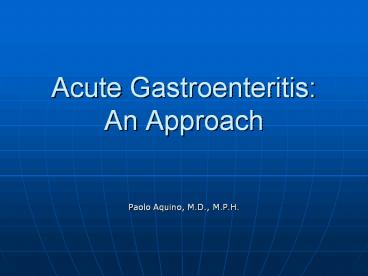Acute Gastroenteritis: An Approach - PowerPoint PPT Presentation
1 / 24
Title:
Acute Gastroenteritis: An Approach
Description:
Acute Gastroenteritis: An Approach Paolo Aquino, M.D., M.P.H. Outline Approach Etiology Diagnosis Treatment Prevention Approach Acute Abdomen Approach History ... – PowerPoint PPT presentation
Number of Views:310
Avg rating:3.0/5.0
Title: Acute Gastroenteritis: An Approach
1
Acute Gastroenteritis An Approach
- Paolo Aquino, M.D., M.P.H.
2
Outline
- Approach
- Etiology
- Diagnosis
- Treatment
- Prevention
3
Approach
- Considerations
- Rule out acute/surgical abdomen
- Hydration status
4
Acute Abdomen
Intraluminal Obstruction Extraluminal Obstruction Gastrointestinal Disease Paralytic Ileus Blunt Trauma Miscellaneous
Foreign Body Bezoar Fecalith Gallstone Parasites Cystic fibrosis Tumor Fecaloma Hernia Intussusception Volvulus Duplication Stenosis Tumor Mesenteric cyst SMA syndrome Pyloric stenosis Appendicitis Crohn disease Ulcerative colitis Vasculitis Peptic ulcer disease Meckels AGE Sepsis Pneumonia Pyelonephritis Peritonitis Pancreatitis Cholecystitis Renal stones Gallstones PID Lymphadenitis Accident Battered child syndrome Lead poisoning Sickle cell disease Familial Mediterranean fever Porphyria DKA Addisonian crisis Testicular torsion Ovarian Torsion
5
Approach
- History
- Symptoms
- Nausea, emesis, retching
- Abdominal pain
- Bowel movements
- Timing
- Age
- Onset
- Relation to feeds
- Focus of infection, other affected individuals
6
Approach
- Physical examination
- Temperature, heart rate, blood pressure, pain
- Abdominal examination
- Auscultation before palpation
- Palpation
- Masses
- Tenderness
- Auscultation for bowel sounds
7
Approach
- Objectives
- Assess the degree of dehydration
- Prevent spread of the enteropathogen
- Selectively determine etiology and provide
specific therapy
8
Dehydration
- Mild (3-5)
- Normal or increased pulse
- Decreased urine output
- Thirsty
- Normal physical exam
9
Dehydration
- Moderate (7-10)
- Tachycardia
- Little/no urine output
- Irritable/lethargic
- Sunken eyes/fontanelle
- Decreased tears
- Dry mucous membranes
- Skin- tenting, delayed cap refill, cool, pale
10
Dehydration
- Severe (10-15)
- Rapid, weak pulse
- Decreased blood pressure
- No urine output
- Very sunken eyes/fontanelle
- No tears
- Parched mucous membranes
- Skin- tenting, delayed cap refill, cold, mottled
11
Dehydration
- Treatment
- Calculate deficits
- Water dehydration x weight
- Sodium water deficit x 80 mEq/L
- Potassium water deficit x 30 mEq/L
- Treat mild-moderate dehydration with oral
rehydration solutions - May treat severe dehydration with intravenous
fluids - Hyponatremic v. isotonic v. hypernatremic
12
Etiology
- Enteropathogens
- Non-inflammatory vs. inflammatory diarrhea
- Non-inflammatory
- Enterotoxin production
- Destruction of villi
- Adherence to GI tract
- Inflammatory
- Intestinal invasion
- Cytotoxins
13
Etiology
- Chronic diarrhea
- Giardia lamblia
- Cryptosporidium parvum
- Escherichia coli enteroaggregative,
enteropathogenic - Immunocompromised host
- Non-infectious causes anatomic, malabsorption,
endocrinopathies, neoplasia
14
Etiology
- Bacterial
- Inflammatory diarrhea
- Aeromonas
- Campylobacter jejuni
- Clostridium dificile
- E. coli enteroinvasive, O157H7
- Plesiomonas shigelloides
- Salmonella
- Shigella
- Vibrio parahaemolyticus
- Yersinia enterocolitica
15
Etiology
- Bacterial
- Non-inflammatory
- E. coli enteropathogenic, enterotoxigenic
- Vibrio cholerae
- Viral
- Rotavirus
- Enteric adenovirus
- Astroviruus
- Calcivirus
- Norwalk
- CMV
- HSV
16
Etiology
- Parasites
- Giardia lamblida
- Entamoeba histolytica
- Strongyloides stercoralis
- Balantidium coli
- Cryptosporidium parvum
- Cyclospora cayetanensis
- Isospora belli
17
Diagnosis
- History
- Stool examination
- Mucus
- Blood
- Leukocytes
- Stool culture
18
Diagnosis
- Examination for ova and parasites
- Recent travel to an endemic area
- Stool cultures negative for other enteropathogens
- Diarrhea persists for more than 1 week
- Part of an outbreak
- Immunocompromised
- May require examination of more than one specimen
19
Antimicrobial therapy
- Aeromonas
- TMP/SMZ
- Dysentery-like illness, prolonged diarrhea
- Campylobacter
- Erythromycin, azithromycin
- Clostridium dificile
- Metronidazole, vancomycin
- E. coli
- TMP/SMZ
20
Antimicrobial therapy
- Salmonella
- Cefotaxime, ceftriaxone, ampicillin, TMP/SMZ
- Infants lt 3 months
- Typhoid fever
- Bacteremia
- Dissemination with localized suppuration
- Shigella
- Ampicillin, ciprofloxacin, ofloxacin, ceftriaxone
- Vibrio cholerae
- Doxycycline, tetracycline
21
Therapy
- Antidiarrheal medication
- Alter intestinal motility
- Alter adsorption
- Alter intestinal flora
- Alter fluid/electrolyte secretion
- Antidiarrheal medication generally not
recommended - Minimal benefit
- Potential for side effects
22
Prevention
- Contact precautions
- Education
- Mode of acquisition
- Methods to decrease transmission
- Exclusion from day care until diarrhea subsides
- Surveillance
- Salmonella typhi vaccine
23
(No Transcript)
24
Any questions?































